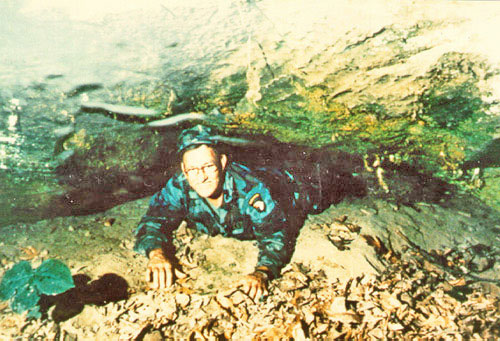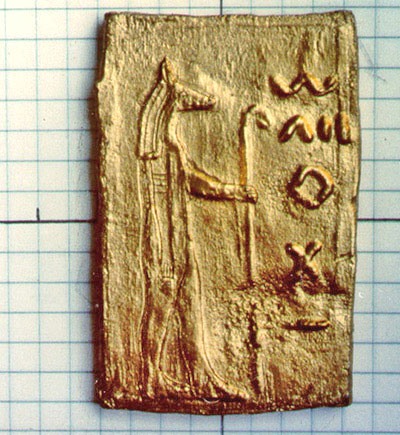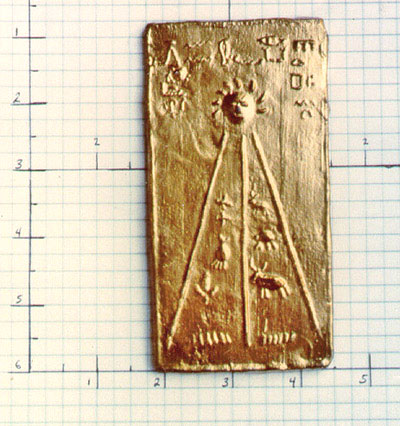|
|
|
11 February, 2005
from
ThothWeb Website
This article takes a quick look at a controversial site in Illinois called Burrows Cave.
In 1982 a large quantity of epigraphic material was been found there by it’s discoverer, a gentleman by the name of Russell Burrows. What is claimed by Burrows certainly doesn’t seem to be readily digestible by mainstream archeologists, but that of course is neither here nor there.
It has been said that some of the
artifacts found are somewhat reminiscent of the Davenport, Iowa, and
Wilmington, Ohio, tablets, both of which are of doubtful
authenticity. Feel free to read the article below, take a look
at the images and draw your own conclusions.
His weight on the side of this rock flipped it as if on a pivot and he fell into a pit below the rock....
He found himself in a chamber, with a huge face on one wall, and continues....
The cave is said to lie somewhere along the Skillet Fork of the Little Wabash River in southeastern Illinois.
It supposedly contains 13 elaborately ornamented burial crypts. It is unclear and a matter of controversy who, besides Burrows, has actually been inside the cave . What is known is that Burrows has produced hundreds, if not thousands, of curiously carved stones that he says came from this cave. And some of the artifacts allegedly were not of stone, but of gold.
It is claimed that Burrows sold off enough artifacts to unknown buyers that he was able to place $7 million in Swiss numbered bank accounts. According to Swiss journalist Luc Buergin, this money derives from the illegal sale of gold artifacts from the North American burial site.
Other sources claim that Burrows melted down all the gold and sold it as ingots. Still others question whether there ever was any gold in the first place.
Edge of the rock
cliff, approx. 300 ft. from the entrance to the cave.
A bizarre collection of artifacts was found in a remote cave system in the American State of Illinois. The cavers who made the discovery encountered a derisive response from the first academic experts they approached, experiencing a lot of difficulty finding necessary specialists to help them document and identify the artifacts.
There were problems of site security, disappearing artifacts, as well as people bending data to suit their personal agendas. As the site researcher Fred Rydholm remarks: "For this kind of research you have to be thick-skinned, brave or crazy!" It’s one thing finding these things, its quite another to explain them.
In the United States the saga of "Burrows Cave" has been going on for many years. Over three thousand rock fragments, engraved with a variety of ancient drawings, hieroglyphs and script, were presented to the world by Russell Burrows in 1982, who discovered them in a cave system in Southern Illinois. The story of the cave and its contents is so strange, that it’s little wonder it has met strong skepticism.
Recently deciphered for the first time, the stone tablets tell such a wild tale that it will require quite a turn around to accepted history. I was stunned into disbelief when I first laid eyes on the Burrows Cave evidence.
This is no straight forward set of hieroglyphs but, an inexplicable display of several cultures, a huge library preserved on stone tablets, collected together and sealed in a cave sometime around the first millennium.
Gold artifact from the cave, clearly showing
Egyptian or Egyptian inspired marks on the
gold.
The first photographs of the artifacts were forwarded to me by Filip Coppens, who writes about world mysteries in Belgium.
He had heard about my investigation of the
anomalies surrounding the presumed hoax of Egyptian hieroglyphs in
the NSW Hunter Valley. He was struck by certain odd similarities
between the two finds and sent pictures of the carvings which
depicted a wolf-headed god, similar to an "Anubis" carving
photographed in the Hunter Valley.
There are also many carved heads, mostly warrior profiles, wearing both Greek, Roman and Egyptian headgear.
Curiously, there are even images of ancient Amer-Indians wearing feathers and facial designs, some showing clear Meso-American style head-dress. Records of ancient travellers? Amongst them are many ancient mystical and sacred designs, as well as maps, pictures of ships and non-indigenous animals.
Astonishingly, one of the carvings portrays the cloven-hooved god Pan, holding his pipes and consorting with a nymph. Another stone (as well as an ancient metal coin) excavated from the cave carry the bold image of an elephant underlined with Hebrew characters.
Oddly, an artifact inscribed in exactly the same way was found on a pyramid-shaped stone in Ecuador some years earlier. Some of the carvings are meticulously executed in full bas-relief, some completely carved into the shapes of animals and deities, while other tablets were etched to render the designs.
Even a small collection of solid gold artifacts and coins have been excavated. More than just pictures, there are numerous tablets with coherent linear script carved on them. Examples and influences appear to range from Hebrew and Sumerian to Roman, Greek and Egyptian.
In my correspondence with Fred Rydholm, the best theory I could offer, was to speculate about a colony of resourceful pirates, who in some distant time, raided and collected the strange quasi-cultural cache of artifacts for themselves.
Together with an associate Dr James Scherz, who helped in the study and documentation of the artifacts, Fred Rydholm found correlations between symbols on the Burrows Cave coins and coins produced by dynasties along the "Silk Road" between China and Rome, the most predominant being "Kushana" and "Satavahana" symbols.
(NOTE: The Kushanas once controlled a trade dynasty along the Silk Roads, uniting various ancient people’s in the days of the Romans. They disintegrated with the collapse of the Western part of the Roman Empire about AD 300. The Satavahana’s were a seafaring people who lived on the coast of the Indian Ocean and had large ships represented on their coins before they collapsed around 210-230 AD. This suggests the likely time period of early in the first millennium around or after 200 AD.)
Finally, Fred Rydholm was able to report
a significant breakthrough with two young Florida researchers, Paul Schaffranke and
Brian Hubbard, who were successful in deciphering
some of the inscriptions. Schaffranke and Hubbard
recognized them as
being one of several ancient Etruscan alphabets which could be
translated into "street Latin", as used around the time of
Christ.
Dr Joseph Mahan, founder and longtime president of the Institute for the Study of American Cultures (ISAC), has examined the evidence from the new translations and presents this interesting scenario:
The graves of these people have been the
object of a comprehensive historical search for the past two
thousand years. We appear to have an advanced and well funded group
of priest/scholars who, with the ex-Royal families, escaped the
Roman Christianization of Egypt and set off into the unknown
somewhere around 200-300 AD. The engraved maps and their collected
storehouse of knowledge, shows a deliberate transplanting of
culture, perhaps to escape the religious persecution of the Roman
Invasion of Egypt and establish a remote colony which could preserve
the ancient records.
A mysterious culture concentrated along the
Mississippi, known as the "Mississippian", crystallized
around 800 AD, and was thought to still be in existence when the
Spaniards arrived. Researcher, Joseph Mahan, points out, that
archeologists have collected evidence for fifty years of an
elaborate and uniform Earth/Sun religion, associated with the
building of flat top temple mounds, which spread out from the
Mississippi in the later part of the first millennium.
Examples of these mound sites are spread from Oklahoma, to Illinois, Alabama and Georgia.
|









